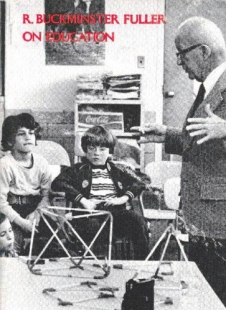
Publication of the book R. Buckminster Fuller: On Education
R. Buckminster Fuller finally in Czech
The title On Education by R. Buckminster Fuller – one of the most significant inventors, visionaries, and thinkers of the 20th century – is currently reaching bookstore shelves. In it, the author conditions the future survival of humanity on a revolution in the educational system.
The title On Education is almost prophetic (for example, at the time of its first publication, the author predicted the emergence of the internet and the rapid development of information technologies). The book consists of supplemented notes from Fuller’s lectures, which he typically delivered from memory at many universities around the world. In these essays, the author shows how education influences our understanding of reality. He considers classical schooling to be false because it relies on idealized thought constructs that have no support in reality and as a result obscure it instead. He is also deeply disturbed by the arrangement and development of the world, and while contemplating the present of humanity, he conditions its subsequent positive development on a fundamental reform in the way education is approached. Everything is subordinated to the fundamental idea characteristic of all his work: How to use the world's resources more effectively through new, more complex, scientifically grounded proposals.
In On Education, Buckminster Fuller draws from his multifaceted personal experiences: a nerd disliked by classmates and teachers, who was expelled twice from Harvard for "lack of interest" in studies, became an internationally renowned architect, a respected inventor, and a self-taught scientist, ultimately spending most of his time lecturing to thousands of students around the world.
In addition to unconventional views of the world and fresh insights, the book will also present several original teaching methods and tools designed to better understand the functioning of the universe, of which Earth and humanity are a natural part.
In Czech, the title was published by MOX NOX, and the texts were translated by Alena Všetečková. However, the book captivates not only with its content but also with Fuller’s unique style – he tried to invent a new language for new ideas, which sometimes also involved established terms that he deemed misleading, and therefore he replaced them with more appropriate expressions. Last but not least, it draws attention with its unconventional graphic design, created by the Czech-Dutch graphic studio The Rodina.
The book is paperback and has 224 pages. You can purchase it on the publisher's website or at selected bookstores. The title was published with the support of the Czech Architecture Foundation.
The title On Education is almost prophetic (for example, at the time of its first publication, the author predicted the emergence of the internet and the rapid development of information technologies). The book consists of supplemented notes from Fuller’s lectures, which he typically delivered from memory at many universities around the world. In these essays, the author shows how education influences our understanding of reality. He considers classical schooling to be false because it relies on idealized thought constructs that have no support in reality and as a result obscure it instead. He is also deeply disturbed by the arrangement and development of the world, and while contemplating the present of humanity, he conditions its subsequent positive development on a fundamental reform in the way education is approached. Everything is subordinated to the fundamental idea characteristic of all his work: How to use the world's resources more effectively through new, more complex, scientifically grounded proposals.
In On Education, Buckminster Fuller draws from his multifaceted personal experiences: a nerd disliked by classmates and teachers, who was expelled twice from Harvard for "lack of interest" in studies, became an internationally renowned architect, a respected inventor, and a self-taught scientist, ultimately spending most of his time lecturing to thousands of students around the world.
In addition to unconventional views of the world and fresh insights, the book will also present several original teaching methods and tools designed to better understand the functioning of the universe, of which Earth and humanity are a natural part.
In Czech, the title was published by MOX NOX, and the texts were translated by Alena Všetečková. However, the book captivates not only with its content but also with Fuller’s unique style – he tried to invent a new language for new ideas, which sometimes also involved established terms that he deemed misleading, and therefore he replaced them with more appropriate expressions. Last but not least, it draws attention with its unconventional graphic design, created by the Czech-Dutch graphic studio The Rodina.
The book is paperback and has 224 pages. You can purchase it on the publisher's website or at selected bookstores. The title was published with the support of the Czech Architecture Foundation.
The English translation is powered by AI tool. Switch to Czech to view the original text source.


0 comments
add comment












